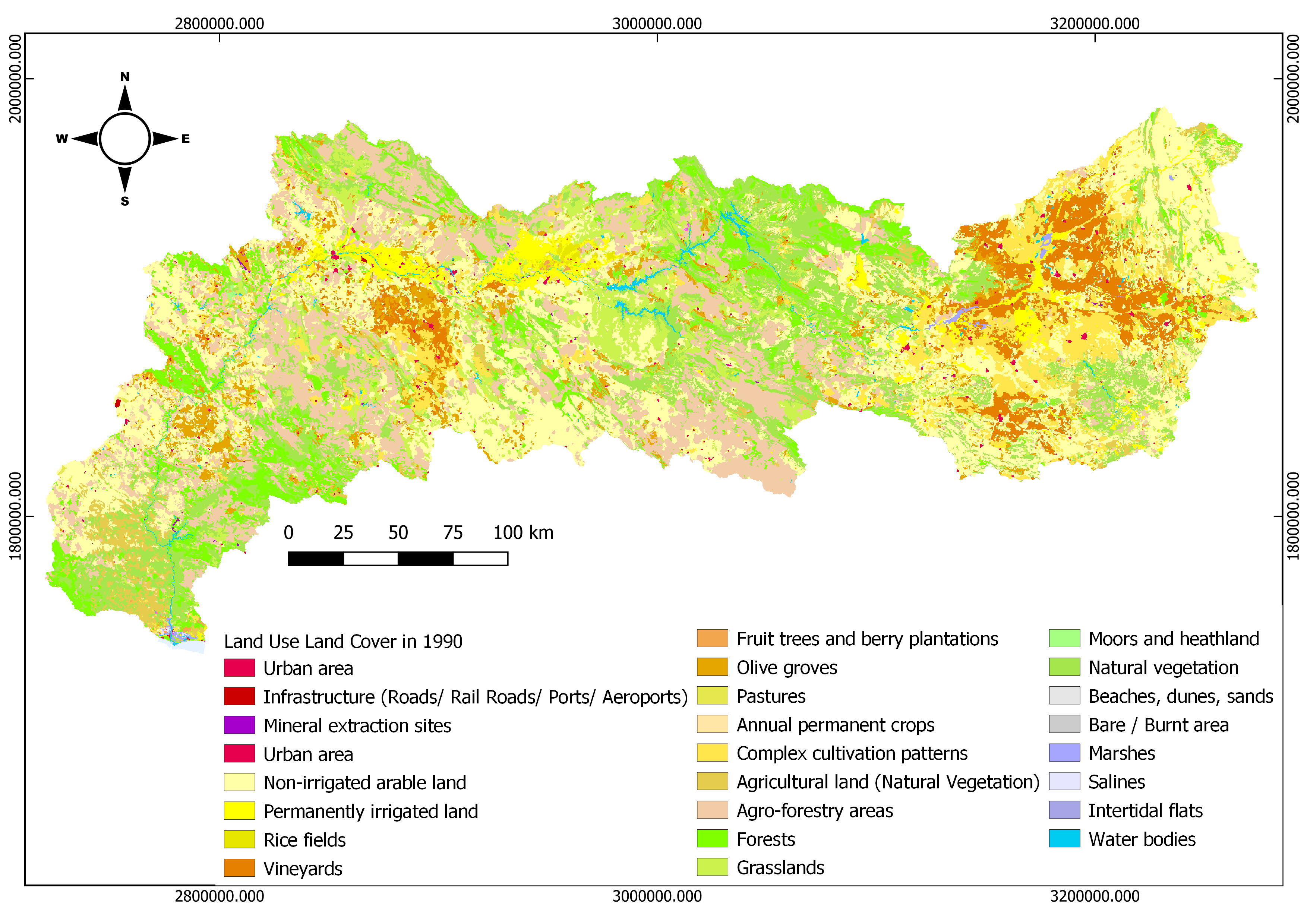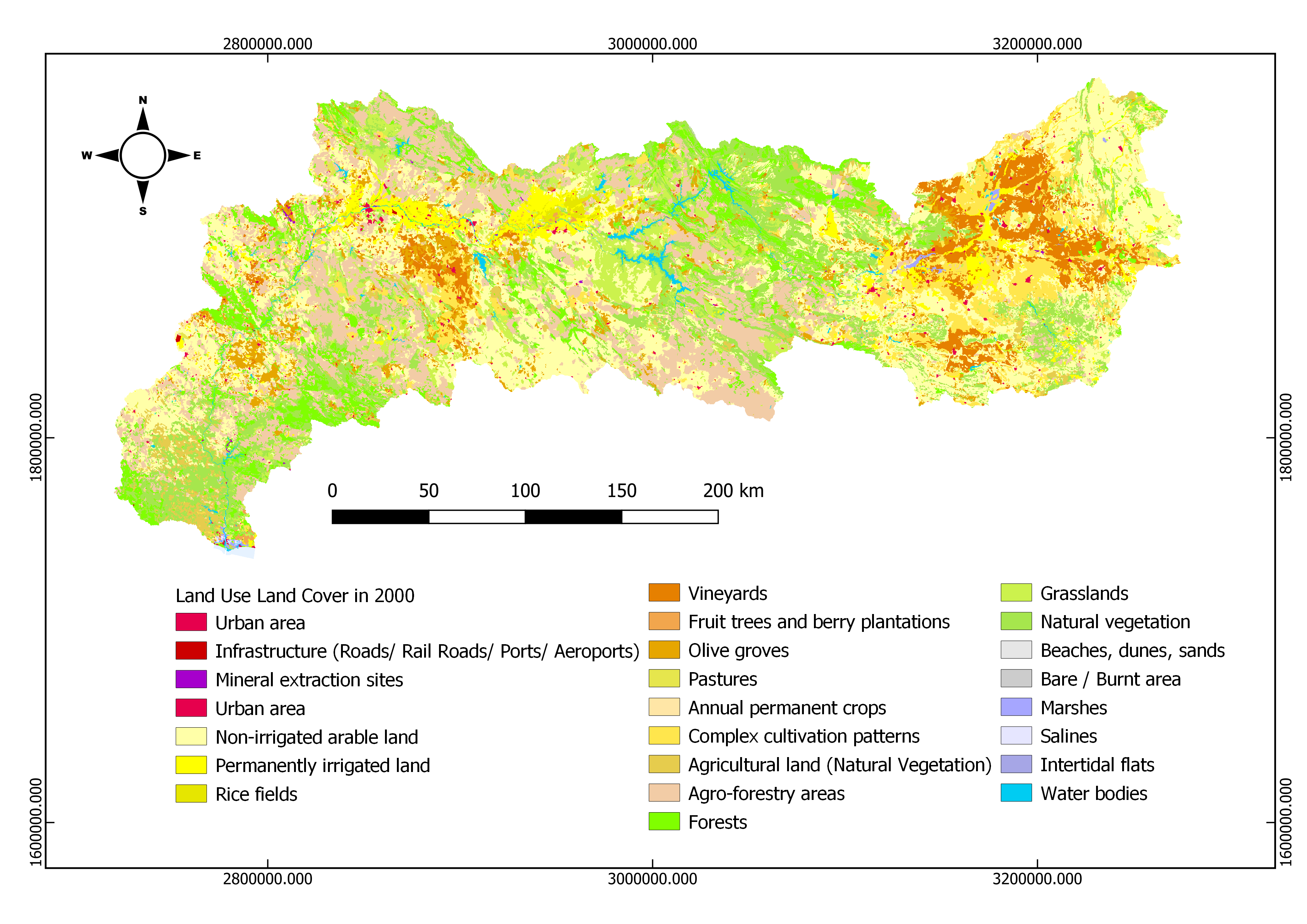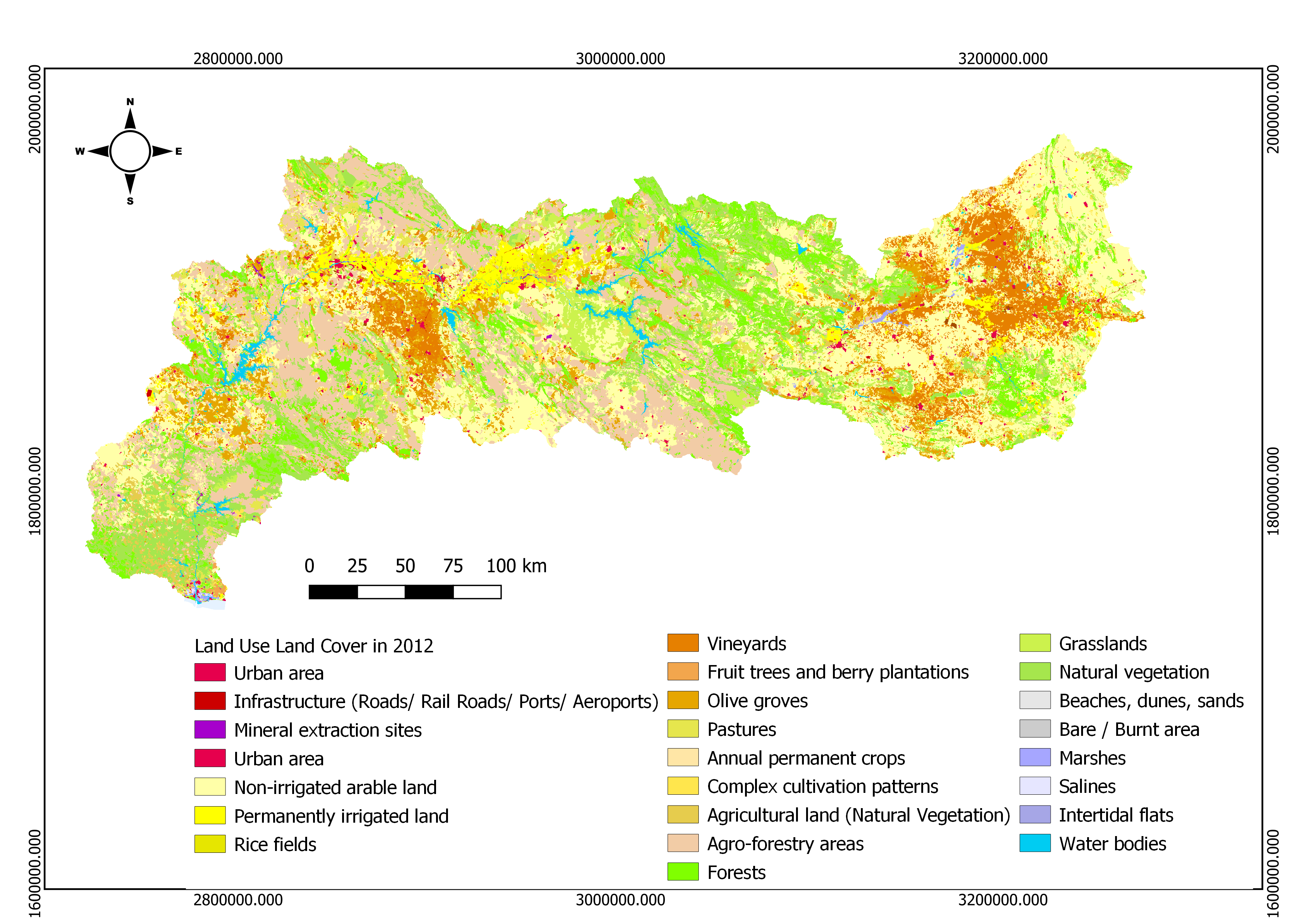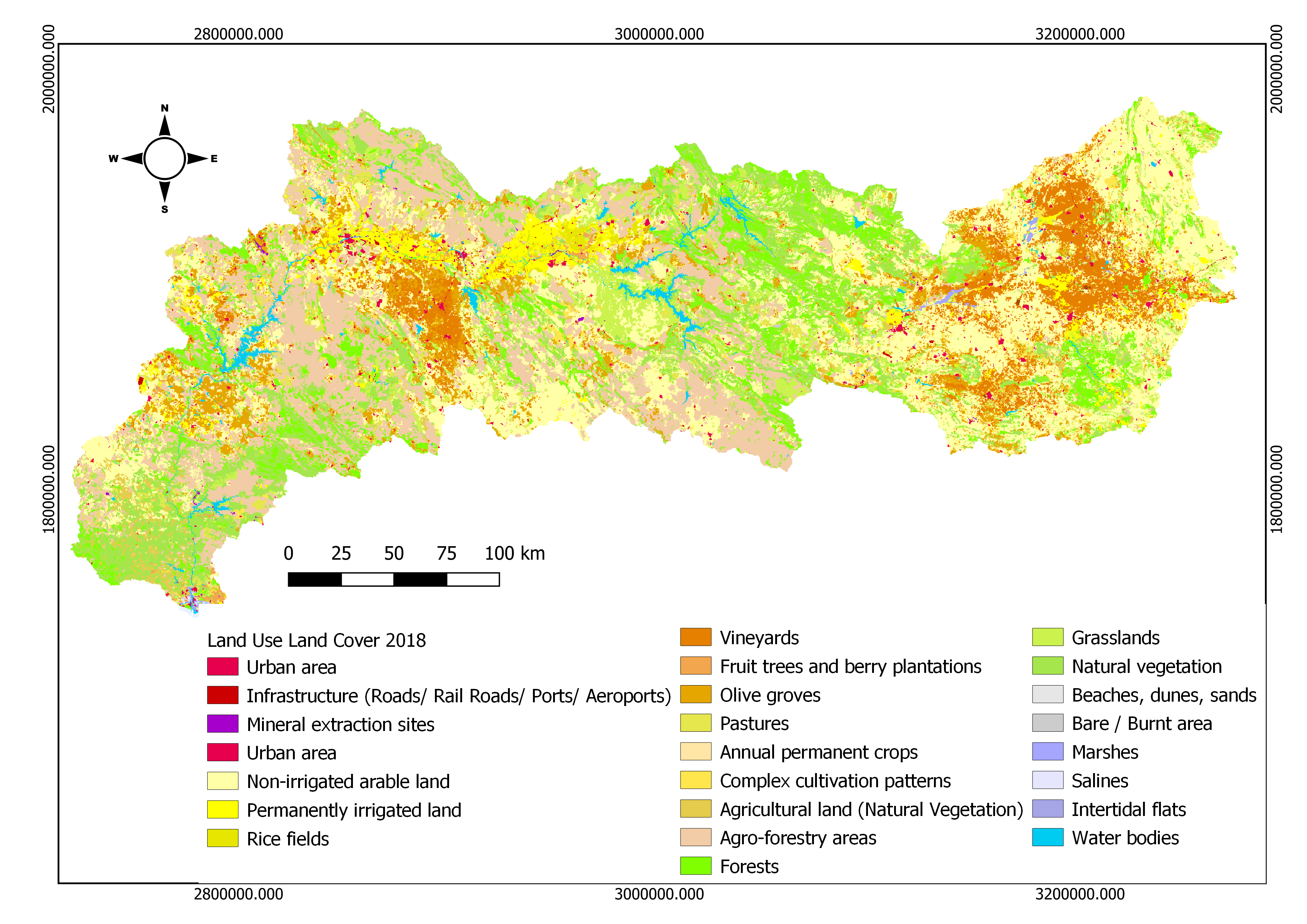Guadiana River Basin, Spain/Portugal
Socio-Economic Development
The Guadiana River Basin played and still plays a crucial role in the region's economic development: Although the Guadiana River Basin is located in a semiarid region, groundwater use has helped transform the rural areas of the basin into agricultural and industrial centers. Historically, the region's economy has mainly depended on wheat, vines, and sheep rearing, but it has evolved into an economically viable region (Llamas et al., 2005; Stratton et al., 2008).
Population and Water Demands
Around 1.5 million inhabitants live in the Spanish territory, mostly in rural areas (Palop-Donat et al., 2020). Urban water demands account for 8.92% of the total water demand, and the Spanish Water Law priorities human water supplies above all other uses. The main water demands come from the agricultural sectors and account for 89.11% of the total water demands. Industrial uses are relatively small at 1.96%. Other non-consumptive water uses include hydropower, aquaculture, and recreational uses (Montesinos, 2012).
Land Use and Land Cover Changes
The maps in Figure 1 (a-d) present the variation of land use and land cover within the Guadiana basin across 44 classes in 1990, 2000, 2012, and 2018.
(a) 1990

(b) 2000

(c) 2012

(d) 2018

Figure 1 (a-d): Land Use and Land Cover (LULC) Changes in the Guadiana River Basin. 1990-2018. (Map by Chahinaz Ziani).
The class with the highest areal loss is "natural vegetation," with a total change of around -1,600Km² between 1990 and 2018. Humans have primarily cleared the sclerophyllous vegetation and forests (here: coniferous, mixed, and broad-leaf forests) between 1990 – 2006. At the same time, the basin has gained transitional woodland shrubs with a total gain of 1,000 km² during the same period. A numerical breakdown of the total changes is provided in Table 1 below.
Table 1: Trends in LULC Changes accross the Guadiana River Basin by category. 1990-2018. (by Chahinaz Ziani).

Key Challenges
However, the Guadiana River Basin is highly prone to water scarcity, and competition among water users is high, making the management of the Guadiana River Basin a complex task. Particularly overexploitation of ground- and surface water resources is a vital issue for the local ecosystem and socio-economic development (Llamas et al., 2013; Palop-Dunat et al., 2020).
Since 1970 the overexploitation of groundwater for crop irrigation has lowered the water table. Because of this, the main river channels have run dry, and the wetlands have started to desiccate. Even though water abstraction has collaborated in strengthening the agricultural sector, at the same time has generated conflicts between farmers, local government, regulators, and conservationists, that have not yet been resolved (Llams et al., 2013). Another critical problem is the illegal water abstraction in the Guadiana River Basin via illegal wells (Stratton et al., 2008).
Governance and Drought
The Albufera Treaty, the Amendment Protocol of 2008, and the EU Water Framework Directive form the legal framework for governing the transboundary basin (JafroudiI, 2008).
In the context of international drought management, the transboundary cooperation between Portugal and Spain resulted in the development of a drought and water scarcity indicator system and additional measures to reduce drought vulnerability and impacts on agriculture (Maia & Vicente-Serrano, 2017).
Good transboundary cooperation remains a future challenge for Spain, especially for Portugal, since Portugal’s parts of the watershed are located downstream. This means that Portugal depends on the quantity and quality of water coming from Spain. Even though international agreements about the basin’s water resources exist, future challenges will keep emerging, making joint actions and further dialogues necessary (UNDRR, 2021).
References
Center for International Earth Science Information Network - CIESIN - Columbia University. 2018. Gridded Population of the World, Version 4 (GPWv4): Population Density, Revision 11. Palisades, New York: NASA Socioeconomic Data and Applications Center (SEDAC). https://doi.org/10.7927/H49C6VHW. Accessed 14 June 2022.
Jafroudi, M. (2018): Climate change and accommodation of water availability in transboundary rivers: lessons learned from the Guadiana basin. In: Water Policy, 20(2), 203–217. https://doi.org/10.2166/wp.2018.178
Llamas, M.R., Varela-Ortega, C., De La Hera, A., Aldaya, M.M., Villarroya, F., Martinez- Santos, P., Blanco-Guiterrez, I., Carmona-Garcia, G., Esteve-Bengoechea, P., De Stefano, L., Hernandez-Mora, N., ZORRILLA, P. (2013): The Guadiana basin. In: Mysiak, J.; Henrikson, H.J.; Sullivan, C.; Bromley, J.; Pahl-Wostl, C. (Ed.): The Adaptive Water Resource Management Handbook, pp. 103-116. Oxford: Taylor and Francis. DOI:https://doi.org/10.4324/9781315065984.
Maia, R., Vicente-Serrano. S. (2017): Drought Planning and Management in the Iberian Peninsula. In: Wilhite, D. and Pulwarty, R. (ed) Drought and Water Crises: Integrating Science, Management, and Policy, 1st ed. Taylor & Francis Group, pp 481-505.
Montesinos, S. (2012): SYSTEM OF ECONOMIC & ENVIRONMENTAL ACCOUNTS FOR WATER IN GUADIANA RIVER BASIN GUASEEAW FINAL REPORT (Technical Part).Available at: https://ec.europa.eu/environment/water/blueprint/pdf/GuaSEEAWreport.pdf
Palop-Donat, C., Paredes-Arquiloa, J., Solera, A., & Andreu Álvarez, J. (2020): Comparing performance indicators to characterize the water supply to the demands of the Guadiana River basin (Spain). In: Hydrological Sciences Journal, 65(7), 1060-1074. doi:https://doi.org/10.1080/02626667.2020.1734812
Stratton, S. E., Simon, L. K., Marchiori, C. (2008): Promoting Groundwater Reform in the Guadiana Basin. In: American Journal of Agricultural Economics, 90(5), 1343–1349. doi: https://doi.org/10.1111/j.1467-8276.2008.01228.x
United Nations Office for Disaster Risk Reduction (UNDRR) (2021): GAR Special Report on Drought 2021. Geneva.

